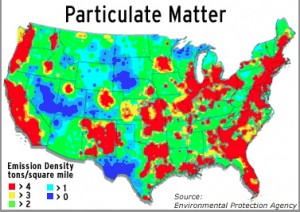Autism
Study: PM Pollution is an “Environmental Neurotoxin” to Brain
 It was just two months ago we featured the results of a study out of Boston that linked exposure to Particulate Matter, or PM pollution to brain aging and increased risk of dementia. Before that, we highlighted studies linking PM to autism and Parkinson-like symptoms. Now comes one more long-term, peer-reviewed report that connects ambient levels of the pollution to accelerated brain aging.
It was just two months ago we featured the results of a study out of Boston that linked exposure to Particulate Matter, or PM pollution to brain aging and increased risk of dementia. Before that, we highlighted studies linking PM to autism and Parkinson-like symptoms. Now comes one more long-term, peer-reviewed report that connects ambient levels of the pollution to accelerated brain aging.
This one is from the University of Southern California and looked at over 1,400 women without dementia who were initially enrolled in a large health study from 1996 to 1998. Researchers measured their brain volume with M.R.I. scans in 2005 and 2006, when the women were 71 to 89 years old.
Using residential histories and air pollution monitoring data, they estimated their exposure to PM air pollution from 1999 to 2006. For each increase of 3.49 micrograms per cubic centimeter (μg/m3) cumulative exposure to PM, there was an associated 6.23 cubic centimeter reduction in the subject's brain white matter, the equivalent of one to two years of brain aging. The current EPA standard for 24 PM exposure is 35 μg/m3, while the annual average standard is 12 μg/m3, although many leading scientists now believe there's no "safe" level of exposure to PM pollution. That is, any amount of exposure is capable of doing some damage.
The association between pollution exposure and brain aging in the USC study remained after adjusting for many variables, including age, smoking, physical activity, blood pressure, body mass index, education and income.
“This tells us that the damage air pollution can impart goes beyond the circulatory system,” said the lead author, Dr. Jiu-Chiuan Chen, an associate professor of preventive medicine at the Keck School of Medicine at the University of Southern California. “Particles in the ambient air are an environmental neurotoxin to the aging brain.”
It's important to note that all of these women were subject to ambient levels of PM pollution, that is, levels that we're all being exposed to on a daily basis living in the modern world. Everyday kinds of exposure to this substance is making our brains age prematurely.
What makes PM pollution dangerous to human health is the fact that its soot particles are so tiny that they can actually cross from the lungs into the blood stream and travel anywhere in the body, including the brain. Soot is a toxic substance on its own, but when its carrying the residues of whatever was burned to produce it – benzene in a combustion engine, mercury from the coal in a power plant, dioxins from "hard to recycle plastic waste" in a cement kiln – it becomes even more dangerous.
While PM pollution remains an important factor in respiratory diseases, heart attacks and strokes, the more insidious effects to the brain it causes are raising its profile among policymakers and activists. They have implications for zoning highways near schools, parks, and residences, as well as pollution control measures at industrial facilities.
PM is one of the best examples of "the closer we look, the more trouble we find" phenomena in environmental health science. Advances in technology and medicine show that subtle changes in exposure to chemicals that went unnoticed before can have profound consequences to our species.
Are Environmental Causes Behind a “Pandemic” of Child Brain Disorders?
 Anecdotally you may have heard commentary from a friend about the large numbers of kids in their child's age group who seem to have something wrong with their brain – ADHD or Autism for example. Turns out, there's some solid statistical evidence those conditions are on the rise.
Anecdotally you may have heard commentary from a friend about the large numbers of kids in their child's age group who seem to have something wrong with their brain – ADHD or Autism for example. Turns out, there's some solid statistical evidence those conditions are on the rise.
According to the U.S. Centers for Disease Control, almost two million more children in the U.S. were diagnosed with developmental disabilities in the mid-Oughts than in the mid-1990's. This same decade saw autism climb nearly 300 percent, while that of attention deficit hyperactivity disorder increased 33 percent.
In total, the CDC concludes that 10-15 percent of kids born in America have some type of "neurobehavorial development disorder" and many more were have milder afflictions that don't necessarily rise (yet) to the level of an official diagnosis. These rising numbers are why some leading researchers are saying we're experiencing a "pandemic" level of child brain disorders.
Genetics are believed to account for as much as 30-40 percent of that increase (whether it's genetics or "epigenetics" isn't examined). However, study after recent study also suggests that environmental exposures play a significant role.
Last month, Journalist Elizabeth Grossman wrote about the insidious impact of toxins on the brains of children, either while they're still in the womb or in their early years as their brains are still developing. She describes both indoor and outdoor exposure pathways that offer a multitude of opportunities for kids or pregnant mothers to be exposed to chemicals that can have both subtle and profound impacts on brain behavior.
There are the bad ones we know so much about but can't seem to eliminate from the marketplace, like lead, that still turns up in plastic "softeners" and imported paints. But there's also the threat that grows from fine particulate matter with almost every new research effort published, as well as more ubiquitous chemicals used in fire retardants (PBDEs) plastics (BPA and phthalates), and "perfluorinated compounds" used in stain resistant coatings and pesticides.
Only since the 1980's have scientists realized how much more vulnerable the brains, and hormones, of kids are to the impact of toxins. Even "low levels" of exposures at the wrong time in fetal development can have big consequences. One research is quoted by Grossman as saying that "timing determines destination."
In terms of air pollution, there are now numerous studies linking Particulate Matter (PM) pollution to Autism, including one published as recently as December from the Harvard School of Public Health showing that mothers exposed to high levels of the pollution were twice as likely to give birth to children diagnosed with the disorder.
Pregnant moms exposed to high levels of Polycyclic Aromatic Hydrocarbons, or PAHs – another by-product of burning stuff – were five times more likely to raise children with Attention Deficit Hyperactivity Disorder according to a recent study published by Columbia University's Mailman School of Public Health.
When you combine these air pollution threats with the retardants on the furniture we buy, the residues of pesticides on the food we eat, and the plastics we eat and drink from, the world looks like a very hostile place for developing minds.
No matter the exposure pathway, the problem is the old familiar one of an outdated and slow-moving regulatory system dealing with a marketplace where thousands of new chemicals are introduced without proper health screenings for fundamentals like cancer, much less their more subtle impacts on children's brain development. The ability for chemicals to cause harm is outracing the mechanism in place to prevent them. We're still reacting to being poisoned instead of being proactive about preventing it.
Another Study Links Autism to Air Pollution
 The more Ozone and Particulate Matter pollution a baby in the womb is exposed to, the more likely he or she will be born with autism according to a new UCLA study published March 1st in Environmental Health Perspectives, a peer-reviewed journal published by the National Institute of Environmental Health Sciences. It's the largest study of its kind to date and is the first to link autism with ozone, or smog, levels.
The more Ozone and Particulate Matter pollution a baby in the womb is exposed to, the more likely he or she will be born with autism according to a new UCLA study published March 1st in Environmental Health Perspectives, a peer-reviewed journal published by the National Institute of Environmental Health Sciences. It's the largest study of its kind to date and is the first to link autism with ozone, or smog, levels.
Researchers compared levels of air pollutants, mostly related to vehicle traffic, during pregnancy gestation periods of 7,603 children with autism and 75,635 children without autism, born from 1995 to 2006 in Los Angeles. Babies at the 75th percentile of exposure to toxins had a 8 percent to 10 percent higher risk of autism than babies at the bottom 25th percentile, the study said. Ozone and fine particulates had the strongest association with autism.
Using government air monitoring stations, researchers estimated average exposures during pregnancy to carbon monoxide, nitrogen dioxide, nitric oxide, ozone and particulate matter. The study adjusted for factors that include maternal age, birthplace, race and education. Using birth certificates, researchers compared control children with non-control children who had matching birth year, sex and gestational age at birth.
"These findings are of concern, since traffic-related air pollution is ubiquitous," said Dr. Beate Ritz, chair of UCLA's Department of Epidemiology and the study's senior author. She said she was reluctant to advise expectant mothers to leave LA or polluted cities, because that's not an option for many. "We can't tell them to not breathe or not go outside or not go to work," she said. She did recommend avoiding sitting in traffic, when pollutant exposure is worst."
Autism is a spectrum of disorders ranging from a profound inability to communicate and mental retardation to milder symptoms seen in Asperger's syndrome. The Centers for Disease Control and Prevention estimates that autism affects one in every 88 children born in the U.S., a 25 percent increase from 2006.
Research on autism and exposure to chemicals has been limited. Studies from 2006 and 2010 found an association between autism and air pollutants from industries and other sources.
A study in 2010 was the first to look at autism and toxins specifically from auto exhaust. The study, based in California, reported that children born to mothers living within 9/10 mile of a freeway during pregnancy were more likely to be diagnosed with autism than children whose mothers lived more than 1/4 mile from a freeway. However, the sample size — 304 autism cases and 259 controls — was much smaller than the just-published UCLA study.
Most policy discussions concerning air pollution in DFW surround the damage done to lungs, or maybe hearts and lungs. Rarely are the other, now well-known associations between air pollution and birth defects, or air pollution and brain function mentioned. And even rarer is the fact mentioned that these harms are often occurring at levels of pollution considered to be officially "safe" or at least legal. We really have no idea what the assault on our bodies by chemicals we involuntarily breathe actually can do to our health over the long term. That's why we should minimize exposure to them as much as possible. And that means limiting the chemicals' movements, not those of expectant moms.
“There are no safe doses for endocrine disruptors”
That’s the conclusion of a new report that was three years in the making. Dr. Laura Vandenburg of Tufts University led 12 other scientists in an effort that examined hundreds of recent studies on the effects to people and animals of hormone-changing chemicals that are widely used in industry, including cosmetics, pesticides and plastics. They found that even tiny doses of these chemicals, called “endocrine disruptors,” can cause harmful health effects such as infertility, cardiovascular disease, obesity, and cancer. Writing in a separate editorial about the report, Vandenburg stated that “After reviewing hundreds of studies, my colleagues and I have concluded that there truly are no safe doses for these hormone-altering chemicals. We found overwhelming evidence that these hormone-altering chemicals have effects at low levels, and that these effects are often completely different than effects at high levels. For example, a large amount of dioxin would kill you, but a very small dose, similar to what people are exposed to from eating contaminated foods, increases women’s risk of reproductive abnormalities.” In North Texas, we’re not only surrounded by endocrine disruptors in products we buy, but also in the air we breath. Lead from Exide’s Frisco smelter is an endocrine disruptor. Many of the pollutants released by the Midlothian cement plants – TXI, Holcim and Ash Grove – are endocrine disruptors, as are a good percentage of the chemicals emitted by the gas industry when its fracking a well. Like so many other kinds of human-made pollutants, endocrine disrupters were allowed in commerce without full understanding of their possible public health effects. That’s why the report also recommends that the way the government tests for a chemical’s toxicity be modernized. Currently, there’s no evaluation of health effects from endocrine disruptors at the low level of exposure encountered by most people. These chemicals actually can harm you more in smaller doses over a long period of time than really high short term exposures. It’s called a “non-linear” response because it doesn’t follow the old “the dose is the poison” rule that makes the amount of poison the driver of any possible toxic effects. “Current testing paradigms are missing important, sensitive endpoints” for human health, Vandenburg and Co. said.“The effects of low doses cannot be predicted by the effects observed at high doses. Thus, fundamental changes in chemical testing and safety determination are needed to protect human health.” In other words, we need a system that catches these chemicals before they’re widely marketed in consumer products, or released as pollution into the environment; before we become unwitting lab rats.
Traffic Jams Your Lungs and Brain
Here’a a good summary piece in the Wall Street Journal (sub required, but this link seems to get you past that) about the large number of studies going on attempting to understand how traffic jam pollution affects human health. So far, researchers have shown connections to not only the obvious respiratory illnesses cause by breathing in bad stuff, but also to behavioral development, IQ, autism, and depression. “The evidence is growing that air pollution can affect the brain,” says medical epidemiologist Heather Volk at USC’s Keck School of Medicine. ‘We may be starting to realize the effects are broader than we realized.” So true for a countless number of pollutants these days. Which is why it’s always better to prevent their creation and release in the first place.
New Study: Environment Bigger Factor than Genetics in Autism
“Environmental factors play a more important role in causing autism than previously assumed and, surprisingly, an even larger role than genetics, according to a new study out of UCSF and Stanford that could force a dramatic swing in the focus of research into the developmental disorder.”
